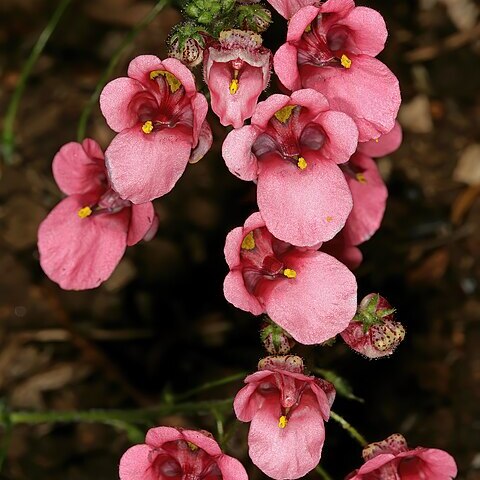Diffuse annual herb, main stem up to 750 mm long, 3-4 mm diam., simple or branching low down into spreading panicles, glabrous becoming glandular-pubescent on the inflorescence axes. Leaves glabrous, mostly 16-50 x 18-40 mm, smaller upwards, ovate, apex acute to obtuse, base subcordate, margins often sharply serrate, occasionally only obscurely so; petiole 5-16 mm long. Flowers many in somewhat crowded or more lax and flagelliform racemes often compounded into panicles; lowermost bracts leaf-like, rapidly smaller upwards and then mostly 3-4 x 1-2 mm, lanceolate, acute to acuminate, mostly glandular-pubescent, hairs occasionally few or wanting; pedicels mostly 11-20 mm long, filiform, mostly wide-spreading, glandular-pubescent. Calyx segments lanceolate, very acute, glandular-pubescent, two anticous ones c. 3 x 0.751.25 mm, three posticous ones slightly smaller. Corolla tube c. 3 mm long, invaginated, two lateral spurs c. 3-5 mm long, curved downwards, with a patch of dark sessile glands within near the tips; limb c. 17 x 15 mm, anticous lobe c. 8-9 x 8-9 mm, two lateral lobes 3.5-5 x 4-6 mm, two posticous lobes c. 3 x 3-4 mm, all subrotund, rose-pink, sparsely glandular-pubescent outside, glabrous inside, without sessile glands on the palate, which is scarcely raised; “window” concave, c. 1.5 mm deep. Stamens projecting forward, filaments 3 mm long, glandular-puberulous; anthers 0.75-1 mm long, cohering strongly. Ovary 1.25-1.5 x 0.75-1 mm, ovules at least 6 in each loculus; style 2.25-2.5 mm long; stigma capitate, lying between the anthers. Capsules c. 4.5-6 x 2-3 mm; seeds 1.25 mm long, weakly ridged.
More
Annual herb (sometimes flowering as a seedling), stems up to 1 m long; simple or basally branching. Leaves ovate, apex various; petioles 5-16 mm long. Flowers sometimes in dense racemes; pedicels mostly 11-20 mm long, spreading. Corolla: lobes rose to reddish pink, palate hardly raised; window single, deeply sunk in a larger hollow. Spurs ± 3-5 mm long, curving downwards. Flowering time Sept.-Mar., mainly Apr.

